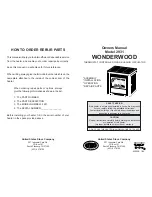
39
5
823
1
10a
12
Freestanding Installations
If the chimney connector must pass through a combustible wall to reach
the chimney, follow the recommendations in the Wall Pass-Through
section that follows.
The opening through the chimney wall to the flue (the “breach”) must be
lined with either a ceramic or metal cylinder, called a “thimble”, which is
securely cemented in place. Most chimney breeches incorporate
thimbles, but the fit must be snug and the joint between the thimble and
the wall must be cemented firmly (Fig. A)
A special piece called the “thimble sleeve”, slightly smaller in diameter
than standard connectors and most thimbles, will facilitate the removal of
the chimney connector system for inspection and cleaning. Thimble
sleeves are available from your local dealer.
To install a thimble sleeve, slide it into the breech until it is flush with the
inner flue wall. Do not extend it into the actual flue passage, as it could
interfere with the draft.
The thimble sleeve should protrude 1-2” (25-50 mm) into the room. Use
fire cement and thin gasketing to seal the sleeve in place in the thimble.
Secure the chimney connector to the outer end of the sleeve with sheet
metal screws.
Above a Fireplace
In this installation, the chimney connector rises from the stove, turns 90°,
and then goes into the fireplace chimney (Fig. B) The liner of the fireplace
chimney should extend at least to the point at which the chimney
connector enters the chimney. Follow all the guidelines for installing a
chimney connector into a freestanding masonry chimney, and pay special
attention to these additional points:
•
Double check the connector clearance from the ceiling: 18” minimum.
•
The fireplace damper must be closed and sealed to prevent room air
from being drawn up the flue, thereby reducing the draft. However, it
must be possible to re-open the damper to inspect the chimney.
Wall Pass-Throughs
Whenever possible, design your installation so that the wall connector
does not pass through a combustible wall. If you are considering a wall
pass-through in your installation, check with your building inspector before
you begin. Also check with the chimney connector manufacturer for any
specific requirements.
Accessories are available for use as wall pass-throughs. If using one of
these, make sure it has been tested and listed for use as a wall pass-
through.
The National Fire Protection Association (NFPA) has established
guidelines for passing chimney connectors through combustible walls.
Содержание HARMONY I
Страница 5: ...395823110a 5 Combustion System Stanford 80 and Harmony I...
Страница 6: ...395823110a 6 Combustion System Stanford 140 and Harmony III...
Страница 11: ...395823110a 11...













































